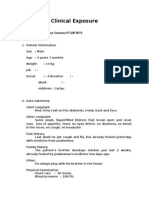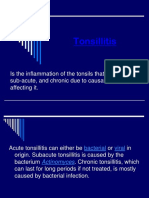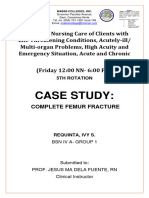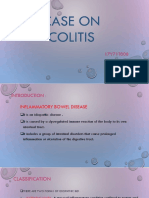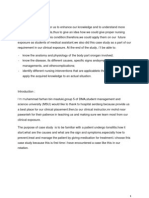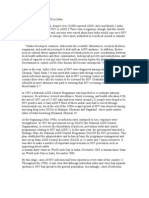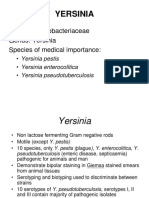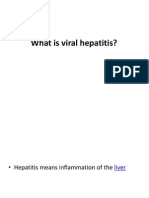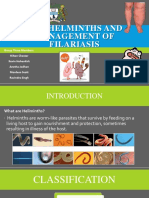Chickenpox Chickenpox Is A Highly Contagious Disease Caused by Primary Infection With Varicella Zoster
Chickenpox Chickenpox Is A Highly Contagious Disease Caused by Primary Infection With Varicella Zoster
Uploaded by
subbu2raj3372Copyright:
Available Formats
Chickenpox Chickenpox Is A Highly Contagious Disease Caused by Primary Infection With Varicella Zoster
Chickenpox Chickenpox Is A Highly Contagious Disease Caused by Primary Infection With Varicella Zoster
Uploaded by
subbu2raj3372Original Description:
Original Title
Copyright
Available Formats
Share this document
Did you find this document useful?
Is this content inappropriate?
Copyright:
Available Formats
Chickenpox Chickenpox Is A Highly Contagious Disease Caused by Primary Infection With Varicella Zoster
Chickenpox Chickenpox Is A Highly Contagious Disease Caused by Primary Infection With Varicella Zoster
Uploaded by
subbu2raj3372Copyright:
Available Formats
Chickenpox Definition Chickenpox is a highly contagious disease caused by primary infection with varicella zoster virus (VZV).
It usually starts with vesicular skin rash mainly on the body and head rather than at the periphery and becomes itchy, raw pockmarks, which mostly heal without scarring. in the oral cavity and tonsil areas. "hickenpo! is an airborne disease which spreads easily through coughing or sneezing by ill individuals or through direct contact with secretions from the rash. # person with chickenpo! is infectious one to two days before the rash appears. $hey remain contagious until all lesions have crusted over (this takes appro!imately si! days). Immuno compromised patients are contagious during the entire period as new lesions keep appearing. "rusted lesions are not contagious. "hickenpo! has been observed in other primates, including chimpanzees and gorillas. $he origin of the term chicken pox, which is recorded as being used since %&'(, is not reliably known. It has been said to be a derived from chickpeas, based on resemblance of the vesicles to chickpeas, or to come from the rash resembling chicken pecks. ther suggestions include the designation chicken for a child (i.e., literally )child po!)), a corruption of itching-pox, or the idea that the disease may have originated in chickens. *amuel +ohnson e!plained the designation as ,from its being of no very great danger., Signs and symptoms $he early (prodromal) symptoms in adolescents and adults are nausea, loss of appetite, aching muscles, and headache. $his is followed by the characteristic rash and-or oral sores, malaise, and a low.grade fever that signal the presence of the disease. ral manifestations of the disease (enanthem) not uncommonly may precede the e!ternal rash (e!anthem). In children the illness is not usually preceded by prodromal symptoms, and the first sign is the rash or the spots in the oral n e!amination, the observer typically finds skin lesions at various stages of healing and also ulcers
cavity. $he rash begins as small red dots on the face, scalp, torso and upper arms and legs/ progressing over %01%2 hours to small bumps, blisters and pustules/ followed by umbilication and the formation of scabs. #t the blister stage, intense itching is usually present. 3listers may also occur on the palms, soles, and genital area. "ommonly, visible evidence of the disease develops in the oral cavity 4 tonsil areas in the form of small ulcers which can be painful or itchy or both/ this enanthem (internal rash) can precede the e!anthem (e!ternal rash) by % to 5 days or can be concurrent. $hese symptoms of chickenpo! appear %0 to 2% days after e!posure to a contagious person. #dults may have a more widespread rash and longer fever, and they are more likely to e!perience complications, such as varicella pneumonia. 3ecause watery nasal discharge containing live virus usually precedes both e!anthem (e!ternal rash) and enanthem (oral ulcers) by % to 2 days, the infected person actually becomes contagious one to two days prior to recognition of the disease. "ontagiousness persists until all vesicular lesions have become dry crusts (scabs), which usually entails four or five days, by which time nasal shedding of live virus also ceases. "hickenpo! is rarely fatal, although it is generally more severe in adult men than in women or children. 6on.immune pregnant women and those with a suppressed immune system are at highest risk of serious complications. #rterial ischemic stroke (#I*) associated with chickenpo! in the previous year accounts for nearly one third of childhood #I*. $he most common late complication of chickenpo! is shingles (herpes zoster), caused by reactivation of the varicella zoster virus decades after the initial, often childhood, chickenpo! infection. 7hat are the causes of chicken po!8 #s mentioned above, chicken po! is caused by a virus, called varicella zoster. 9eople become infected after being in contact with an infected child or adult "hicken po! is one of the most infectious diseases around . appro!imately :0; of those who have never had chickenpo! or were not vaccinated will become infected when they come into contact with the varicella zostervirus.
"hicken po! and colds and flu spread in a similar way. <roplets of water that are e!pelled from the nose and mouth of the infected person through coughs and sneezes are inhaled by those around them. $he contaminated droplets float in the air. If the contaminated droplets land on surfaces and ob=ects, they too can become sources of infection if other people touch them. Shingles . a person who never had chicken po! or was never vaccinated can catch chicken po! from people with shingles, an infection also caused by the varicella zoster virus. >owever, you cannot get shingles from somebody with chickenpo!. Chickenpox Incubation Period It takes between %0 and 2% days after contact with an infected person for someone to develop chickenpox (this is known as the chickenpo! incubation period). 7hile this is the complete range for the chickenpo! incubation period, the usual chickenpo! incubation period averages between %( and %& days. Diagnosis $he diagnosis of varicella is primarily clinical, with typical early ,prodromal, symptoms, and then the characteristic rash and oral.cavity sores. "onfirmation of the diagnosis can be sought through either e!amination of the fluid within the vesicles of the rash, or by testing blood for evidence of an acute immunologic response. Vesicular fluid can be e!amined with a $zanck smear, or better by testing for direct fluorescent antibody. $he fluid can also be ,cultured,, whereby attempts are made to grow the virus from a fluid sample. 3lood tests can be used to identify a response to acute infection (Ig?) or previous infection and subse@uent immunity (IgA). 9renatal diagnosis of fetal varicella infection can be performed using ultrasound, though a delay of B weeks following primary maternal infection is advised. # 9"C (<6#) test of the mother)s amniotic fluid can also be performed, though the risk of spontaneous abortion due to
the amniocentesisprocedure is higher than the risk of the baby developing fetal varicella syndrome. Prevention Hygiene measures $he spread of chickenpo! can be prevented by isolating affected individuals. "ontagion is by e!posure to respiratory droplets, or direct contact with lesions, within a period lasting from three days prior to the onset of the rash, to four days after the onset of the rash. $he chickenpo! virus is susceptible to disinfectants, notably chlorine bleach (i.e., sodium hypochlorite). #lso, like allenveloped viruses, it is sensitive to desiccation, heat and detergents. Vaccine # varicella vaccine was first developed by ?ichiaki $akahashi in %:D( derived from the ka
strain. It has been available in the E* since %::B to inoculate against the disease. *ome countries re@uire the varicella vaccination or an e!emption before entering elementary school. 9rotection from one dose is not lifelong and a second dose is necessary five years after the initial immunization, which is currently part of the routine immunization schedule in the E*. $he chickenpo! vaccine is not part of the routine childhood vaccination schedule in the EF. In the EF, the vaccine is currently only offered to people who are particularly vulnerable to chickenpo!. # vaccinated person is likely to have a milder case of chickenpo! if infected. Treatment $reatment mainly consists of easing the symptoms as there is no actual cure of the condition. *ome treatments are however available for relieving the symptoms while the immune system suppresses the virus in the body. #s a protective measure, patients are usually re@uired to stay at home while they are infectious to avoid spreading the disease to others. #lso, sufferers are fre@uently asked to cut their nails short or to wear gloves to prevent scratching and to minimize the risk of secondary infections.
$he condition resolves by itself within a couple of weeks but meanwhile patients must pay attention to their personal hygiene. $he rash caused by varicella zoster virus may however last for up to one month, although the infectious stage does not take longer than a week or two. #lthough there have been no formal clinical studies evaluating the effectiveness of topical application of calamine lotion, a topical barrier preparation containing zinc o!ide and one of the most commonly used interventions, it has an e!cellent safety profile. It is important to maintain good hygiene and daily cleaning of skin with warm water to avoid secondary bacterial infection. *cratching may also increase the risk of secondary infection. #cetaminophen (paracetamol) but not aspirin may be used to reduce fever. #spirin use by someone with chickenpo! may cause the serious, sometimes fatal disease of the liver and brain, Ceye syndrome. 9eople at risk of developing severe complications who have had significant e!posure to the virus may be given intra.muscular varicella zoster immune globulin (VZIA), a preparation containing high titres of antibodies to varicella zoster virus, to ward off the disease. Children If oral acyclovir is started within 2( hours of rash onset it decreases symptoms by one day but has no effect on complication rates. Ese of acyclovir therefore is not currently recommended for immunocompetent individuals (i.e., otherwise healthy persons without known immunodeficiency or on immunosuppressive medication). "hildren younger than %2 years old and older than one month are not meant to receive antiviral medication unless they are suffering from another medical condition which would put them at risk of developing complications. $reatment of chickenpo! in children is aimed at symptoms while the immune system deals with the virus. 7ith children younger than %2 years cutting nails and keeping them clean is an important part of treatment as they are more likely to scratch their blisters more deeply than adults. #spirin is highly contraindicated in children younger than %& years as it has been related with a potentially fatal condition known as Ceye)s syndrome.
*ome parents believe that it is better for children to contract chickenpo! than to get the vaccine, and they deliberately e!pose their children to the virus, sometimes by taking them to ,chickenpo! parties., *ome doctors counter that children are safer getting the vaccine, which is a weakened form of the virus, than getting the disease, which can be fatal. dults Infection in otherwise healthy adults tends to be more severe. $reatment with
antiviral drugs (e.g. acyclovir or valacyclovir) is generally advised, as long as it is started within 2(1(' hours from rash onset. Cemedies to ease the symptoms of chickenpo! in adults are basically the same as those used on children. #dults are more often prescribed antiviral medication as it is effective in reducing the severity of the condition and the likelihood of developing complications. #ntiviral medicines do not kill the virus, but stop it from multiplying. #dults are also advised to increase water intake to reduce dehydration and to relieve headaches. 9ainkillers such as paracetamol (acetaminophen) are also recommended as they are effective in relieving itching and other symptoms such as fever or pains. #ntihistamines relieve itches and may be used in cases where the itches prevent sleep, because they are also sedative. #s with children, antiviral medication is considered more useful for those adults who are more prone to develop complications. $hese include pregnant women or people who have a weakened immune system. *orivudine, a nucleoside analogue has been reported to be effective in the treatment of primary varicella in healthy adults (case reports only), but large.scale clinical trials are still needed to demonstrate its efficacy. #fter recovering from chickenpo!, it is recommended by doctors that adults take one in=ection of VZV immune globulin and one in=ection of varicella vaccine or herpes zoster vaccine.
Complications of Chickenpox *kin infection is the most common complication of chickenpo!. *kin infections occur when bacteria from your skin or under your fingernails get into a chickenpo! blister. *ometimes a skin infection from chickenpo! can be serious. ther complications of chickenpo! are rare. $hey includeG
Varicella pneumonia. 9neumonia can develop if the chickenpo! virus travels to your lungs. 9neumonia from chickenpo! is most common in teens, adults, andpregnant women who have chickenpo! in the last part of pregnancy. It is also more likely to develop in people who smoke cigarettes, have lifelong (chronic) lung diseases, or have impaired immune systems.
Inflammation (swelling) of the brain, known as encephalitis. Hncephalitis can develop about B to %0 days after the chickenpo! rash appears. In children, encephalitis most often affects a specific part of the brain (cerebellum) and is called acute cerebellar ata!ia. It mainly causes poor muscle coordination, although other symptoms of encephalitis can also occur. In adults, this complication is more likely to affect a bigger part of the brain and cause more severe symptoms. Hncephalitis symptoms include confusion, a high fever, a severe headache, sleepiness, sensitivity to light, and nausea. In the most serious cases, a person may have seizures or tremors. $reatment may include medicine to help relieve symptoms. *ome people who have encephalitis may need to stay in the hospital.
Vision loss. "hickenpo! virus that spreads into the clear eye covering (cornea) can leave scars that can cause vision loss.
Ceye syndrome. Ceye syndrome can develop in young people who takeaspirin during chickenpo! or flu treatment. It can be prevented by not giving aspirin to anyone under the age of 20.
Inflammation of the =oints (arthritis). *ometimes people with chickenpo! have pain in their muscles and =oints. $his pain usually lasts as long as the chickenpo! rash. ?edicines taken for fever or other general illness often help ease the pain. $he following complications of chickenpo! are very rareG
Inflammation of the nerves of the eye (optic neuritis) or the spinal cord. Inflammation of the tissues surrounding the brain and spinal cord (meningitis). 6erve damage that causes problems with movement of the face or other parts of the body. "ertain blood disorders, such as a decrease in the number of blood cells that help clot blood (thrombocytopenia).
<eath. 7omen who are pregnant when they have chickenpo! are at risk for complications such as premature labor or varicella pneumonia, and the fetusis at risk of developing chickenpo!. Ietuses with chickenpo! are more likely to develop birth defects or other complications before and after birth. 6ewborn babies can also get chickenpo! when their mother has the illness within a few days of delivery.
You might also like
- International Business EnvironmentDocument6 pagesInternational Business Environmentsubbu2raj3372No ratings yet
- Teaching Plan - ImmunizationsDocument3 pagesTeaching Plan - ImmunizationsDarien Herrera82% (11)
- Case Report ChickenpoxDocument6 pagesCase Report ChickenpoxNofilia Citra CandraNo ratings yet
- Background: Pediatric Chickenpox Next Section: PathophysiologyDocument12 pagesBackground: Pediatric Chickenpox Next Section: PathophysiologyRachel Johann Aquinto100% (1)
- EPIGLOTTITISDocument11 pagesEPIGLOTTITISMinutes in MEDITATIONNo ratings yet
- Mumps (Parotitis)Document28 pagesMumps (Parotitis)Muna Fiah100% (1)
- NCP For Bronchopneumonia With 7 Nursing DiagnosisDocument4 pagesNCP For Bronchopneumonia With 7 Nursing DiagnosisBeng AlontoNo ratings yet
- Acute GastroenteritisDocument13 pagesAcute Gastroenteritismarjorie_11No ratings yet
- Cretenism Case StudyDocument8 pagesCretenism Case StudyMonica Marie MoralesNo ratings yet
- EsophagogastroduodenosDocument4 pagesEsophagogastroduodenosjulia marie candelarioNo ratings yet
- TonsillitisDocument44 pagesTonsillitisBheru Lal100% (1)
- Skin Infestation PDFDocument30 pagesSkin Infestation PDFHampson MalekanoNo ratings yet
- Small Pox: General VirologyDocument24 pagesSmall Pox: General VirologyFahad HassanNo ratings yet
- Acute TonsillopharyngitisDocument39 pagesAcute TonsillopharyngitisCin AtianzarNo ratings yet
- Amoebiasis Is An Infection in The Bowel, Particularly The Colon, Characterized byDocument8 pagesAmoebiasis Is An Infection in The Bowel, Particularly The Colon, Characterized byJamie JunioNo ratings yet
- Assessment Diagnosis Planning Intervention Rationale EvaluationDocument9 pagesAssessment Diagnosis Planning Intervention Rationale EvaluationYzel Vasquez AdavanNo ratings yet
- Case Study - Dengue Fever V - S UtiDocument12 pagesCase Study - Dengue Fever V - S UtiHarlene Joyce ReyNo ratings yet
- Case Study - LeptospirosisDocument3 pagesCase Study - LeptospirosisMarie Jennifer ParilNo ratings yet
- TB Case StudyDocument2 pagesTB Case StudyReisabelle LabianoNo ratings yet
- Case Study: University of Perpetual HelpDocument30 pagesCase Study: University of Perpetual HelpJanine Kristine P. Dayrit100% (3)
- Medical WardDocument15 pagesMedical WardMon Revez LiNo ratings yet
- MIcro Bio Case StudyDocument3 pagesMIcro Bio Case StudyApex Torres0% (1)
- Chicken PoxDocument16 pagesChicken PoxAlbert TerbioNo ratings yet
- Case Study Fracture Femur 1Document16 pagesCase Study Fracture Femur 1Wesley ClacioNo ratings yet
- Case On ColitisDocument34 pagesCase On ColitisAamer SyedNo ratings yet
- CP On AGEDocument31 pagesCP On AGELeah CaressaNo ratings yet
- PoliomyelitisDocument65 pagesPoliomyelitistummalapalli venkateswara raoNo ratings yet
- Sinusitis SymptomsDocument5 pagesSinusitis SymptomsJulliza Joy PandiNo ratings yet
- NCPDocument13 pagesNCPÍam KristineNo ratings yet
- Typhoid FeverDocument11 pagesTyphoid FeverjhenvitoNo ratings yet
- Grand Case DengueDocument14 pagesGrand Case DengueShell BalangueNo ratings yet
- What Are The Symptoms of Chicken PoxDocument6 pagesWhat Are The Symptoms of Chicken PoxManoj CharayaNo ratings yet
- Tuberculous MeningitisDocument11 pagesTuberculous MeningitiszuhriNo ratings yet
- DiphtheriaDocument10 pagesDiphtheriaAgustin IskandarNo ratings yet
- Care Plan Presentation On Meningitis PatientDocument20 pagesCare Plan Presentation On Meningitis PatientDuop Jock LiemNo ratings yet
- NCP Risk For InfectionDocument10 pagesNCP Risk For Infectionson hyejooNo ratings yet
- AADocument20 pagesAAAiyaz AliNo ratings yet
- MSN Ii - 24.6.2020 An-Tonsillitis and AdenoiditisDocument41 pagesMSN Ii - 24.6.2020 An-Tonsillitis and AdenoiditisYAMINIPRIYANNo ratings yet
- Surgical Handwashing and Closed GlovingDocument6 pagesSurgical Handwashing and Closed Glovingklirt carayoNo ratings yet
- Dermatitis: DefinitionDocument5 pagesDermatitis: DefinitionSuhas IngaleNo ratings yet
- Case Study UrtiDocument9 pagesCase Study UrtiHomework PingNo ratings yet
- OBJECTIVES and PATHOPHYSIOLOGY of PHIMOSISDocument5 pagesOBJECTIVES and PATHOPHYSIOLOGY of PHIMOSISShane DamianNo ratings yet
- Congenital Lobar EmphysemaDocument25 pagesCongenital Lobar Emphysemasheme1711No ratings yet
- Mechanisms Case StudyDocument13 pagesMechanisms Case Studyshane_tin143No ratings yet
- Nursing Diagnosis For CholecystectomyDocument2 pagesNursing Diagnosis For CholecystectomyMiguel VillacarlosNo ratings yet
- Case Presentation Hernia 1 PDFDocument21 pagesCase Presentation Hernia 1 PDFMvs ramuNo ratings yet
- Sample Case StudyDocument23 pagesSample Case StudyDELFIN, Kristalyn JaneNo ratings yet
- Schematic Diagram BA HAP HRDocument2 pagesSchematic Diagram BA HAP HRMika MinsalanNo ratings yet
- Case Study Tonsil It IsDocument16 pagesCase Study Tonsil It IsMuhammad FarhanNo ratings yet
- Final Case Study SLDocument17 pagesFinal Case Study SLCharmie Mei Paredes-RoqueNo ratings yet
- Preoperative Skin PreparationDocument16 pagesPreoperative Skin PreparationSyahri DzikriNo ratings yet
- Discharge Planning PaperDocument5 pagesDischarge Planning Paperapi-283173905No ratings yet
- Pulmonary EdemaDocument14 pagesPulmonary EdemaRizzamwah Catague100% (1)
- Typhoid Fever (Enteric Fever)Document24 pagesTyphoid Fever (Enteric Fever)Liza Marie Cayetano AdarneNo ratings yet
- Drug Study - CaseDocument9 pagesDrug Study - CaseMay EvelynNo ratings yet
- Amoebiasis in Wild Mammals: Ayesha Ahmed M Phil. Parasitology 1 Semester 2013-Ag-2712Document25 pagesAmoebiasis in Wild Mammals: Ayesha Ahmed M Phil. Parasitology 1 Semester 2013-Ag-2712Abdullah AzeemNo ratings yet
- Case (Acute Gastroenteritis) Group 4Document36 pagesCase (Acute Gastroenteritis) Group 4EljhayrosNo ratings yet
- Ventricular Septal Defect, A Simple Guide To The Condition, Treatment And Related ConditionsFrom EverandVentricular Septal Defect, A Simple Guide To The Condition, Treatment And Related ConditionsNo ratings yet
- The politics of hunger: Protest, poverty and policy in England, <i>c.</i> 1750–<i>c.</i> 1840From EverandThe politics of hunger: Protest, poverty and policy in England, <i>c.</i> 1750–<i>c.</i> 1840No ratings yet
- Signs and SymptomsDocument6 pagesSigns and SymptomsKajim SharibiNo ratings yet
- VaricellachickenpoxDocument6 pagesVaricellachickenpoxDedi SofyanNo ratings yet
- Tuberculosis 1. Background of The Problem Chickenpox Is A Highly Contagious Disease Caused by Primary Infection With VaricellaDocument6 pagesTuberculosis 1. Background of The Problem Chickenpox Is A Highly Contagious Disease Caused by Primary Infection With VaricellaFkrygeustobat Tikamarimunteupercaya TanyakeunkajalminaNo ratings yet
- Research MethodologyDocument34 pagesResearch Methodologysubbu2raj3372No ratings yet
- Business Case Study 4Document1 pageBusiness Case Study 4subbu2raj3372No ratings yet
- Business Case 3Document1 pageBusiness Case 3subbu2raj3372No ratings yet
- E Tourism LectureDocument24 pagesE Tourism Lecturesubbu2raj3372No ratings yet
- Typologies of E-TourismDocument18 pagesTypologies of E-Tourismsubbu2raj3372No ratings yet
- Procedure Before SearchDocument1 pageProcedure Before Searchsubbu2raj3372No ratings yet
- Consumer Behavior On AutomobilesDocument24 pagesConsumer Behavior On Automobilessubbu2raj3372No ratings yet
- Unmarried Mothe1Document3 pagesUnmarried Mothe1subbu2raj3372No ratings yet
- TransportDocument31 pagesTransportsubbu2raj3372No ratings yet
- National IncomeDocument4 pagesNational Incomesubbu2raj3372No ratings yet
- Questionnaire On Changing Importance of Media Vehicle in Advertising1Document6 pagesQuestionnaire On Changing Importance of Media Vehicle in Advertising1subbu2raj3372No ratings yet
- Brand Management AssignmentDocument10 pagesBrand Management Assignmentsubbu2raj3372No ratings yet
- Account ReceivablesDocument5 pagesAccount Receivablessubbu2raj3372No ratings yet
- Service Quality LiteratureDocument10 pagesService Quality Literaturesubbu2raj3372100% (1)
- Part One: Learning ObjectivesDocument12 pagesPart One: Learning ObjectivesgeombajobsNo ratings yet
- Logistics IndustryDocument8 pagesLogistics Industrysubbu2raj3372No ratings yet
- Industrial SafetyDocument5 pagesIndustrial Safetysubbu2raj3372100% (1)
- Mcdonald Vs KFCDocument17 pagesMcdonald Vs KFCsubbu2raj3372100% (1)
- Literature Review On CRMDocument4 pagesLiterature Review On CRMsubbu2raj3372100% (1)
- Logistics IndustryDocument48 pagesLogistics IndustryTanu NigamNo ratings yet
- Accounts Receivable ManagementDocument7 pagesAccounts Receivable Managementsubbu2raj3372No ratings yet
- Accounts Receivable ManagementDocument4 pagesAccounts Receivable Managementsubbu2raj3372No ratings yet
- Desirable Features of A Grievance ProcedureDocument4 pagesDesirable Features of A Grievance Proceduresubbu2raj3372100% (2)
- NCM107 - Prelim - Teratogenic Maternal Infection and Psychological Changes in Pregnancy - Miss CabalangDocument7 pagesNCM107 - Prelim - Teratogenic Maternal Infection and Psychological Changes in Pregnancy - Miss CabalangLjc JaslinNo ratings yet
- CVIR401 Case #4 PresentationDocument2 pagesCVIR401 Case #4 PresentationTatyanna RammouzNo ratings yet
- The History of HIV AIDS in IndiaDocument2 pagesThe History of HIV AIDS in IndiaAlpesh Suthar100% (2)
- Taenia Saginata: (Taeniarhynchus Saginatus) Beef TapewormDocument12 pagesTaenia Saginata: (Taeniarhynchus Saginatus) Beef TapewormIsabelle Hazel BenemileNo ratings yet
- CertificateDocument1 pageCertificateSiva BandiNo ratings yet
- Filarial WormsDocument8 pagesFilarial WormsDayana PrasanthNo ratings yet
- Chapter 61 Atypical and Parafungal AgentsDocument18 pagesChapter 61 Atypical and Parafungal AgentsbartsnewNo ratings yet
- Implementation of COVID-19 Rapid Antigen Detection Test - PilotDocument3 pagesImplementation of COVID-19 Rapid Antigen Detection Test - PilotPande Putu GinaNo ratings yet
- Nhs Covid Pass - Vaccinated: Covid-19 Vaccine Astrazeneca Covid-19 Vaccine AstrazenecaDocument1 pageNhs Covid Pass - Vaccinated: Covid-19 Vaccine Astrazeneca Covid-19 Vaccine AstrazenecaKarma SucksNo ratings yet
- Post Market Review of Antigen and Rapid Antigen Tests TableDocument33 pagesPost Market Review of Antigen and Rapid Antigen Tests Tableray mantaNo ratings yet
- SSH Memo - Coronavirus Update - 27.04.2021Document8 pagesSSH Memo - Coronavirus Update - 27.04.2021Mr IdealNo ratings yet
- Nursing Care For MeaslesDocument5 pagesNursing Care For MeaslesChristian Eduard de DiosNo ratings yet
- Lab Blood TypesDocument3 pagesLab Blood TypesTrizia M MendezNo ratings yet
- Oral Manifestations of HIV and Its ManagementDocument36 pagesOral Manifestations of HIV and Its ManagementVlkjogfijnb LjunvodiNo ratings yet
- Measles, Mumps, RubellaDocument5 pagesMeasles, Mumps, RubellaRohit KumarNo ratings yet
- Enterobacteriaceae - Non Lactose Fermenters - La 2020Document111 pagesEnterobacteriaceae - Non Lactose Fermenters - La 2020GiselleNo ratings yet
- Class 12 Biology Investigatory ProjectDocument21 pagesClass 12 Biology Investigatory Projectneeraj.messi2008No ratings yet
- Richland County School District 1 COVID ProtocolsDocument1 pageRichland County School District 1 COVID ProtocolsWLTXNo ratings yet
- YersiniaDocument46 pagesYersiniajamal nasir50% (2)
- Ancylostoma DuodenaleDocument20 pagesAncylostoma DuodenaleMladen Vasiljević100% (1)
- I. Mga Nasaliksik Na Impormasyon at Sanggunian:: Jameil Story T. Cabidog Grade 7 - GenerosityDocument31 pagesI. Mga Nasaliksik Na Impormasyon at Sanggunian:: Jameil Story T. Cabidog Grade 7 - GenerosityJames-Sheila CabidogNo ratings yet
- Small Animal Infectious Diseases, Mnemonic Cartoons (VetBooks - Ir)Document57 pagesSmall Animal Infectious Diseases, Mnemonic Cartoons (VetBooks - Ir)dorna.gh90No ratings yet
- Visitors Personal Declaration Form - COVID 19Document1 pageVisitors Personal Declaration Form - COVID 19Leoni FrancNo ratings yet
- Microorganisms Friend or Foe Part-2n ZVDocument27 pagesMicroorganisms Friend or Foe Part-2n ZVrajesh duaNo ratings yet
- The Complete Practitioners Manual of Homoeoprophylaxis by Isaac Golden Reading ExtractDocument14 pagesThe Complete Practitioners Manual of Homoeoprophylaxis by Isaac Golden Reading Extractahlekhuda0% (1)
- Gastrointestinal Manifestation of HIVDocument16 pagesGastrointestinal Manifestation of HIVashuNo ratings yet
- Opv, Amv, Rota & Hib:, Side Effect and Home ManagementDocument5 pagesOpv, Amv, Rota & Hib:, Side Effect and Home Managementjohnlester_jlfNo ratings yet
- Hepatitis A /BDocument79 pagesHepatitis A /BnasibdinNo ratings yet
- Antihelminths and Management of FilariasisDocument38 pagesAntihelminths and Management of Filariasisendeavorx7No ratings yet


